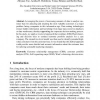2030 search results - page 17 / 406 » Extremal Problems of Information Combining |
CHI
1995
ACM
13 years 11 months ago
1995
ACM
Current networked information systems on the Internet, whilst extremely successful, run into problems of fragmentation, consistency, scalability, and loss of orientation. The deve...
ICDAR
2003
IEEE
14 years 1 months ago
2003
IEEE
The Dempster-Shafer Theory of Evidence is an established method for combining different sources of information. In this paper we explore ways to improve the combination performanc...
HOTOS
1999
IEEE
14 years 6 days ago
1999
IEEE
Wide-area distributed applications are frequently limited by the performance of Internet data transfer. We argue that the principle cause of this effect is the poor interaction be...
SAC
2009
ACM
14 years 2 months ago
2009
ACM
Incorporating background knowledge into data mining algorithms is an important but challenging problem. Current approaches in semi-supervised learning require explicit knowledge p...
INCDM
2010
Springer
13 years 9 months ago
2010
Springer
Abstract. Leveraging the power of increasing amounts of data to analyze customer base for attracting and retaining the most valuable customers is a major problem facing companies i...

